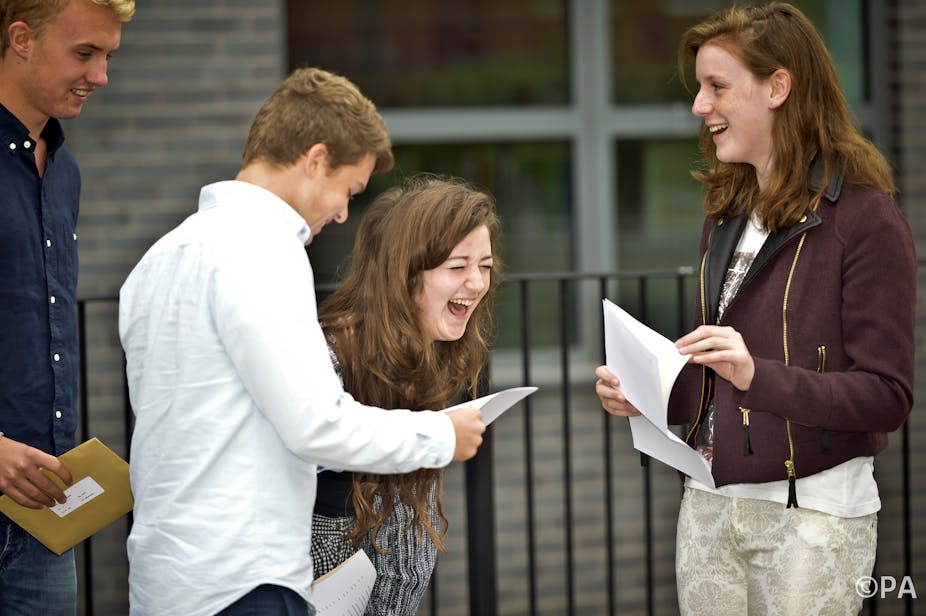Despite a number of dire warnings, overall GCSE results have not been very volatile. Across the country, the number of students getting A* to C grades has increased slightly, by 0.7% points. On the basis of past performance, students who would have received an A or a C grade in 2013, should have received that A or C this year too. But there are some marked subject differences, as well as developments in the number of teenagers taking vocational and computing subjects.
We have already had a relatively boring set of A level results this summer. On the whole, A Level grades were similar to last year’s, with some minor fluctuations, most notably in an increase of students who got A* grade.
Please don’t misunderstand me when I say boring: when it comes to exams, this is a good thing. It reassures us that most students got the grades they deserved. Of course, there will always be exceptions – measurement error in examinations, no matter what the politicians tell us, is inevitable and will always be with us.
For the GCSEs, on a subject-by-subject basis there were notable differences. The A* to C pass rate for English was down 1.9% points, while in mathematics it was up 4.8% points and 6% points in science.

Overall, the number of exam entries was down by over 200,000, from 5.4m in 2013 to 5.2m in 2014, largely due to a 39% drop in the number of entries for Year 10 students. But even these changes are less dramatic than it might seem.
Rise in vocational subjects
Two points I have noted that probably will not get much attention were the increase in the take-up of applied (vocational) GCSEs as well as a dramatic increase in computing and ICT GCSEs, admittedly from a low base.

Business, engineering, health and social care, media studies, hospitality and catering, and leisure and tourism are all on the increase. Some subjects, such as engineering and social care have seen the number of A* to C students increase, while others including leisure and tourism and business studies, have seen a decrease.
As for computing – the number of entries jumped almost fourfold to 16,773 this year. However, there was a slight dip in the numbers of students getting A* to C – down from 68.4% in 2013 to 65.5% this year. Computing now counts as a science, and therefore as one of the subjects in the English Baccalureate, a performance measure of five core subjects now being used in school rankings. The number of ICT entries was also up 40% to 96,811.
Many vocational qualifications are no longer counted as equivalent to GCSEs in this year’s school performance tables, following on from recommendations in Alison Wolf’s 2011 review of vocational qualifications. Those qualifications that are able to be counted now only attract the points-equivalent of one GCSE, when in the past some counted for more. This has discouraged schools from entering students for those qualifications.
But it seems this year’s results show signs that some schools are shifting some of their students into applied GCSEs. This could possibly be in anticipation of counting at least some of the qualification results toward the “best eight” qualifications that will now be the basis of new performance tables, due to be introduced in 2016.
Impact of decline in early entry
Students in England will have taken all of their examinations at the end of their two-year GCSE course because of the government’s insistence on linear qualifications.
For English GCSEs, speaking and listening is now graded separately and does not count in the overall results. Many students in the past have done better in this teacher-marked element than in reading and writing – just think about how verbally articulate most teenagers are and you can see why. English is now 60% externally assessed through examination papers whereas last year it was 40%.
And changes to the way performance tables are structured now mean that only a student’s first attempt at an examination is counted toward the school’s results. Many schools have ceased to enter 15-year-old Year 10 students early for the examinations, resulting in 300,000 fewer early entries this year.
Those schools that made little use of early entry and resits will on the whole have stable or perhaps even better results than last year. For those that made wide use of these practices, the picture could be mixed. Multiple re-sits can just help those students on the border between grade C and grade D to get the higher grade – boosting school results. But taking a qualification at age 16 rather than 15 could mean that students do better because they’ve studied longer and are more mature, pushing results up.

